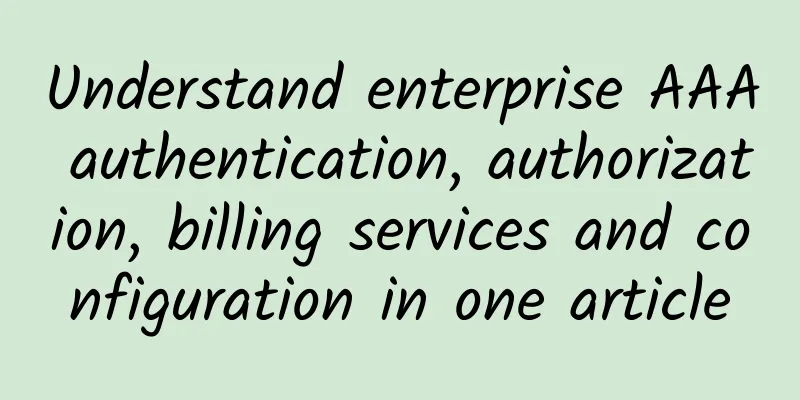Understand enterprise AAA authentication, authorization, billing services and configuration in one article

|
Hello everyone, I am Bernie, an IT pre-sales engineer. If a branch of an enterprise wants to access the headquarters network, the headquarters network is definitely not accessible to everyone, only those who have passed the authentication can access it, such as accessing the OA system, accounting system, ERP system, etc. This is when AAA authentication and authorization services come in handy. AAA is a security service that provides authentication, authorization, and accounting. It can be used to verify whether a user account is legitimate, whether it is authorized to access services, and record access to network resources. About CertificationAuthentication means verifying whether a user has access rights to a network. AAA authentication methods can be divided into three types: no authentication, local authentication, and remote authentication. Not certifiedIt is very simple, which means that the server completely trusts the user and does not perform any identity check on the accessing user. In fact, most networks will not use the non-authentication method because it is too simple and crude and unsafe. Local AuthenticationIt is to configure the user's local information as a parameter on the NAS storage. Local authentication processing speed is fast and the authentication cost is low. However, since the authentication information is stored locally, the amount of data stored is often relatively small. Remote AuthenticationThis method is more advanced. It configures the authentication information on a remote server and uses the authentication server to assist in authentication. Here we need to point out that if an authentication scheme adopts a composite authentication method, that is, multiple authentication methods coexist, for example, local authentication is configured first, and then remote authentication is configured. Then, when local authentication fails or there is no response, remote authentication will be used. About authorizationAuthorization refers to the definition of which services a user is authorized to access on the network. AAA supports the following authorization methods: no authorization, local authorization, and remote authorization. Not authorizedThat is, no authorization is performed on users. There is no restriction on user access, and users can access any service they want. Local authorizationAuthorization is performed based on the relevant authorization attributes configured on the NAS storage. Remote authorizationConfigure authorization information according to the remote server, configure authorization level, etc. Special note: If an authorization scheme uses multiple authorization methods, they will take effect in the configuration order, just like authentication. For example, if you configure remote authorization first and then local authorization, if there is a problem with the remote authorization method, you will request local authorization instead. About BillingBilling is to record a user's use of a service or access to a resource. Unlike authentication and authorization, there is no local billing method. There are only: no billing and remote billing. No chargeInternet access is completely free, and services are all free, such as a company's portal, government portal, etc. Remote BillingThe user's online time or service time is recorded through a remote server to calculate the cost of the service. For example, we can record the host name, online start time, service time, and upstream and downstream traffic during the service period. In this way, we can calculate the traffic cost or service cost. AAA domainAfter talking about authentication, authorization, and accounting, let's take a closer look at the concept of AAA domains. In fact, AAA manages users based on domains, that is, different domains can be associated with different authentication, authorization, and accounting schemes. In a computer network, each host belongs to its own domain. As shown in the figure below, PC1 belongs to areaA, and PC2 belongs to areaB. If you do not configure the domain where the device belongs, the default domain is used by default. SummarizeThe above is all about AAA authentication. For specific authentication configuration, you can first configure the domain authentication scheme, and then configure the domain authorization scheme and authorization method. The article comes from: IT Yizhichan . If you wish to reprint this article, please contact [IT Yizhichan] Toutiao account. |
<<: An article explains the principles of Docker network
>>: Second wave of 5G: 30 countries launch services by 2023
Recommend
How private 5G networks can help companies accelerate their transformation to Industry 4.0
With the rise of IoT applications and the increas...
LOCVPS new Hong Kong VPS high configuration 50% off, 99 yuan/month-dual core/8GB/80GB/30M bandwidth/three network direct connection
LOCVPS has released a permanent 50% discount coup...
China Mobile builds the world's largest 5G network
One year after 5G was officially put into commerc...
What is 5G voice like now?
In the 5G era, real-time communication is still a...
Huawei's Liu Kang: Practicing what we preach and building a 5G core network for deterministic networks
[Shenzhen, China, July 30, 2020] The 2020 Win-Win...
Donghua Software's integrated solution for smart water conservancy operation and maintenance
Do you have such a need? More than 20 local area ...
[Technology Feast] Ruijie Cloud Desktop EST Protocol RUTP Transmission Technology
Preface summary Ruijie Cloud Desktop EST protocol...
Faster network/lower latency Wi-Fi 6E is released: stronger than Wi-Fi 6
As 5G technology develops rapidly, Wi-Fi technolo...
Website built by Alibaba Cloud, fool-proof way to prohibit foreign IP access
1. Introduction The solution is suitable for tech...
Edge Network Speed Requirements
In the previous article, we mentioned how to surv...
7 New Year's Resolutions for the Internet of Things
The beginning of a new year is often a time for p...
The three major operators achieved double growth in revenue and profit: the realization of 5G commercial value has driven the recovery of the industry environment
With a bang, spring comes. It is not only the cli...
Amid the epidemic crisis, many countries are planning to break through with 5G
For the global 5G industry, the first quarter of ...
Qi Chao, Triangle Beast: How to eliminate machines’ misunderstanding of humans
[51CTO.com original article] On July 21-22, 2017,...
Easy-to-understand illustrated network knowledge - Part 2
Continuing from the previous article "Easy...









